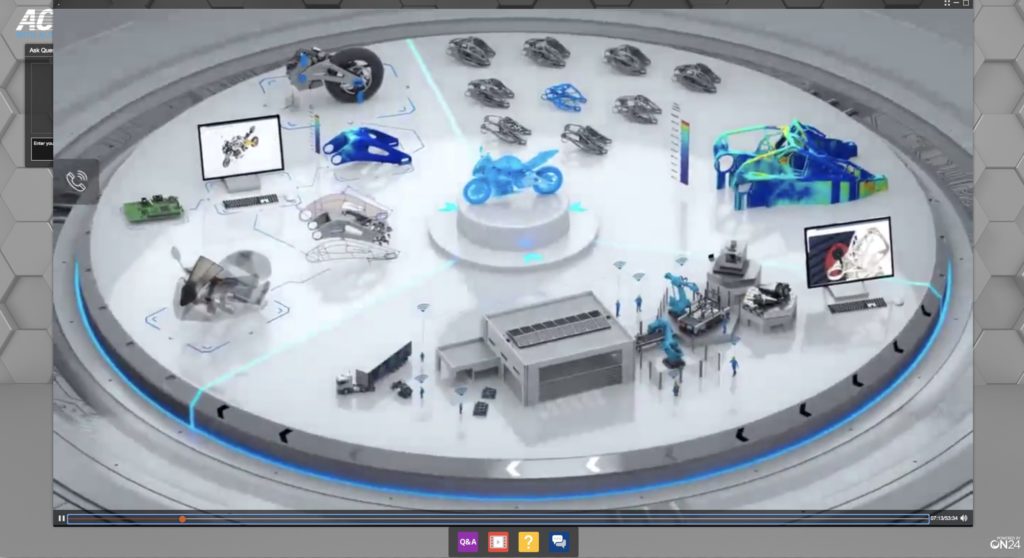
CAD and PLM companies are on the run towards the cloud. Each company has its own journey, stories, strategies, and technologies. But you won’t find any company in the universe of engineering and manufacturing software these days that is not trying to find its path towards the cloud, SaaS, digital transformation, and future platforms.
Earlier this week, I attended the Autodesk Accelerate event presenting the future strategy of the Autodesk One Data Platform. Check my blog here. Autodesk’s cloud journey is interesting – started ten years ago, Autodesk navigated through the multiple generations of development of what is called today Autodesk Forge, Autodesk Fusion360, and other applications. Here is a modern vision of Autodesk platform as of today.

What is interesting in Autodesk platform development is how Autodesk is coming towards the goal of placing data in the center of everything. Started with PLM360 and BIM360, later coming to the visualization platform, transforming and expanding it with the strategy of placing data in the center, Autodesk demonstrates what a decade of development investment and M&A activity can result in building cloud infrastructure.
Today, I attended another vendor virtual event- PTC LiveWorx21 series with the presentation of Jim Hepplemann. Check it out here, you can register for free and watch it. The presentation named Digital Transforms Physical is a masterpiece taking you through the all elements of the PTC portfolio and connects dots between how CAD, PLM, IoT, AR, and SaaS environments are interplaying together to create a new digital universe of PTC solutions.

If you want to call the strategy in one word, you should call it SaaS, because this is where all PTC technologies and products are converging.

Although Autodesk and PTC are very different companies with different portfolios and even different markets, I found one similarity between Autodesk and PTC. Both companies are at SaaS as a strategic platform differentiation. Autodesk Forge and other products are delivered from the public cloud and expand in the direction of providing a single data and solution platform. PTC seems to be doing the same. PTC Atlas platform, which is undergoing active development after the acquisition of Onshape is relying on the platform development by Onsahpe, which presents a modern architecture stack delivering SaaS applications with Onshape at its core.

The comparison of Autodesk and PTC made me think about what we can learn from both companies’ strategies and history of development. Here is my take of 5 points that can help to understand the challenges and complexity of convergence of multiple applications.
1- Desktop applications and files are refusing to die fast.
Files and Desktop applications represent probably the most mature group of engineering software. As much as we hate files and old desktop tools, they refuse to disappear and demonstrate an amazing resilience towards the change. At one moment of time, we thought that internet bandwidth would killfiles. But internet speed was increasing so fast that it now provides enough bandwidth to pass files, which slows down companies’ migration to pure SaaS solutions.
2- Multiple client-server and SaaS products are refusing to converge seamlessly
Data is the core of any software. It can be a relational database or filesystem, modern NoSQL database, or Amazon cloud file storage. Modern SaaS applications are multi-tenant, old applications are SQL-based and single tenant. How to connect all these pieces together. Sometimes it is like water and oil – they refuse to mix.
3- Scalable data management and visualization capabilities are extremely important to create a seamless user experience
To build a solid cloud platform, engineering and manufacturing software companies need to think about data first. Collecting multiple sets of information in a centralized form, managing data records, relationships, to support the demand for flexible data management is an imperative these days. Any engineering platform must provide visualization capabilities for different types of data.
What is my conclusion?
As we can see from the last 10 years of Autodesk experience, converging existing applications and services is a complex task. Autodesk moves to the second and in some places, in the third round of cloud application development, plans gradual retirement or replacement of old systems. It seems to be a natural process of software and platform evolution – Autodesk Vault, BuzzSaw, PLM360, BIM360 – this is a shortlist of products that passed multiple cycles of development and retirement. PTC is now looking into a massive convergence towards SaaS plans. How the process will work and how multiple databases of Windchill, Arena, and Onshape will converge into a single platform architecture? This is an interesting question to ask PTC architects and technologists. What is clear to me is that the path towards future SaaS can be long and unpredictable. Just my thoughts…
Best, Oleg
Disclaimer: I’m co-founder and CEO of OpenBOM developing a digital network-based platform that manages product data and connects manufacturers, construction companies, and their supply chain networks. My opinion can be unintentionally biased.
The post What PTC Can Learn From 10 Years Of Autodesk Cloud Development? appeared first on Beyond PLM (Product Lifecycle Management) Blog.



Be the first to post a comment.